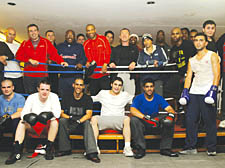|
|
 |
| |

Coaches and boys share a sense of belonging at the club which promotes the discipline of boxing to counter teenage violence |
Young and angry? Step in the ring and sort it out
Boxing club that has moulded champions believes it can channel teenage aggression
YOUTH crime has dominated the headlines in recent months but, as coaches at Islington Boys’ Club will tell you, it is not a new problem.
For 34 years the boxing gym in Hazellville Road, Archway, has been offering teenagers a way to vent their aggression, with a few rounds in the ring.
Coaches at the club believe the discipline and training of boxing could stop youths becoming another grim statistic in London’s teenage violence figures and they have the pedigree to prove it.
Olympic champion Audley Harrison and Commonwealth gold medalist Courtney Fry both lacked discipline when they first came to the club, said trainer Jerry Mitchell, but rigorous training transformed them.
“The club is family for a lot of people – there’s a sense of belonging,” said Mr Mitchell, a trainer for 24 years.
“We’re open to everybody. Here kids can vent their anger in a positive way. A few rounds in the ring gives you a different perspective. We moulded [Audley]. I got him jabbing properly, flooring punches.
“Talent is not the only thing in this game. You’ve got to have heart. Real boxers talk about dying in the ring.”
Paul Hammick, matchmaker and chief coach at the club for seven years, agreed: “It’s not the sort of game you can dabble with.
“There’s a lot of boys who don’t understand the commitment required. You can’t win ’em all but if a boy can accept losing he’s a winner in our eyes.”
Photographs of proud, home-grown fighters – Noel Alleyne (ABA London finalist), John Beckles (two times national ABA champion), Butch Leslie (NABC champion), and a trio affectionately known as “The Three Musketeers”, Gabriel “Gibble” Foley, Michael Brown and José Farrell, line the walls alongside faded pictures of Muhammad Ali and Rocky Marciano.
A placard in the corridor reads: “Boxers do it with uppercuts”; signs demand dorsal raises, dolphin rising, burpee jumps, scissor kicks and jump pikes.
Mr Mitchell continued: “I like to see the kids progress – from when they first come in here and they can’t put their hands up to when they win their first fight, then when they go on to win their first championship.”
Boys can start fighting in one of the club’s three rings from the age of 11.
At the moment they are “building up” with a stable of new fighters. Garv Krasniqi (national novices champ) is regarded as a “good prospect”, and Jose Moreno is an ABA multinational champ.
“There was a lull,” said Mr Mitchell. “Boxing took a bad dive, but it’s coming back now. Next season we’re gonna be putting Islington Boys’ Club back on the map.”
Most of the trainers and staff have years of experience at the club; many fought in the red and white hall – the club’s permanent home since 1981 – as youngsters.
Ron Hagland, the 76-year-old secretary and treasurer, was a volunteer when the club was founded by publican and former boxer Reg Topper in 1974.
Increasing vandalism and disorder had persuaded Mr Topper that he needed to give the area’s youngsters something to do.
The club began life as King’s Cross Amateur Boxing Club in a rented community hall in York Way Court. As members flooded in from across the borough, it changed its name to Islington Boys’ Club.
Mr Topper died shortly after it opened but the team he left behind carried on his work. Mr Hagland, an ex-serviceman, became honorary secretary and fundraiser, and later treasurer.
Despite being well past retirement age, Mr Hagland continues his duties for the club, commuting once a month from Kirby-le-Soken in Essex.
His son, Lenny, who represented England as a youth, also boxed at the club. Oner Avara, who took over as manager from Mr Hagland in 2000, is another former club boxer.
The only concessions the club has made to the 21st century is an electronic buzzer in place of the old-fashioned bell and a keep-fit “boxercise” class upstairs, but tradition may be overruled in favour of a new building in the next few years, warned Mr Hagland.
The existing building, bought for just £50 from Bovis Construction Company, was never meant to be a permanent structure.
New premises have taken longer to achieve than hoped, since the voluntary-run club supports itself. A nominal council grant “covers the electricity bill”.
Mr Hagland said: “We were never good beggars. We went out there and did things for ourselves.
“We’ve always had the ragged arse kids – we’ve never had the poor little rich kids, so we don’t get much in the way of donations from our old boys. But when you see a person you’ve turned around and they give you a hug – that’s the rewards of boxing.” |
 |
|
 |
| |
| |
| |
| |
|
 |
|